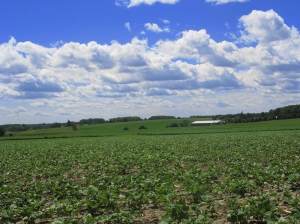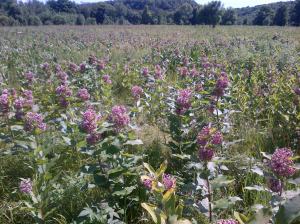Two years ago I wrote a column describing how quickly major global food processors and retailers are moving to create global standards for purchases of ‘sustainably produced’ food ingredients. This change is occurring in direct response to demands from consumers and activist organizations. My column stated that farmers/farm groups need to seize more leadership in this process if they want these standards to reflect/include their own concepts, understanding and experiences for sustainable development – and not just those coming from corporate executives and pressure groups.
Though what lies ahead was obvious two years ago, I am still surprised at the rapidity of the change, with company after company rushing to announce commitments to sustainable development – usually (though not always) followed up with credible implementation strategies. Think of McDonald’s, Walmart, Unilever, Mondelez (formerly Kraft) and many others. The CEO of Cargill was part of an international panel, recently proclaiming a commitment to reduced greenhouse gas emissions. I don’t think that would have happened two years ago. This situation has changed dramatically from 10 years ago when ‘sustainable agriculture’ tended to mean expensive organic vegetables in a pick-up truck.
For sure, some – perhaps even most – of this effort is driven by a desire for image and market share improvement. But it is also driven by a desire of responsible corporate executives to do the ‘right thing.’ Whatever their motives, the result is clear: rapid changes in the global marketplace for agriculture and food.
What’s remarkable is that this trend has blossomed in an era of economic recessions and monetary crises, and with global media headlines featuring food shortages and price concerns. Think what it will be like as media headlines shift to tales about domestic and international grain surpluses.
There are already a huge number of global and regional/national initiatives and standards for sustainable agriculture and food, including several initiatives in Canada. Many of these are commodity- (or commodity-group) specific, eg., palm oil, coffee, potatoes, soybeans, sea foods, pulse crops, to name a few. The biggest international effort may be the European-based Sustainable Agriculture Initiative (SAI). It was started by Unilever, Nestlé and Danone and now includes 60 of the world’s largest food processors and retailers. The SAI web site provides links to a myriad of other sustainability certification programs and a form for assaying the sustainability of individual agricultural operations. It’s called Farm Sustainability Assessment 2.0, and is accessible on-line.
Expect to see the stature and significance of the SAI and SAI-like assessment processes grow in months ahead. This is positive in that global companies are showing much greater interest in how foods are produced/grown. But it’s also very disturbing in that the SAI full membership does not include a single farm group. Indeed, farm groups are not eligible for regular membership – though a half dozen are affiliated members. The latter include the Grain Farmers of Ontario (GFO) and Pulse Canada. GFO is the sole crop-farmer rep on SAI’s Farmer and Supplier Partnership Committee. Thanks to GFO for ensuring there is some farmer input.
Despite GFO efforts, SAI’s Farm Sustainability Assessment 2.0 is still highly superficial and reflects what one might expect from a group weak in farm expertise. For example, the one question on soil erosion is “Do you take measures to avoid soil erosion?” There are only two other questions about soil management. By contrast, there are lots of questions about treatment of farm labour and labour organizations. One example: “Do you ensure that the effective functioning of labor organizations is not opposed?” Check for yourself here (On-line tool or down-loadable Excel file).
While I have featured SAI above, this organization is far from unique among sustainable agricultural initiatives in its membership or approach. Many of them seem more reflective of the agendas of activist groups, compared to farmer experience.
It’s true that there are good examples – particularly for individual companies and specific commodity sectors – where farm groups are larger partners in developing standards for sustainability. One example is the international certification developed by McCain Foods for potatoes which is based in large part on Environmental Farm Plan protocols developed by Canadian farm groups. Another example is McDonald’s commitment to work with beef farmers (more specifically, the Canadian Cattlemen’s Association) in designing standards for purchases of sustainable beef. There are many other examples, most of which I am likely not even aware. But there are also cases of where farmer input appears to have been essentially zero – a high-profile one being policies of A&W for purchases of beef and chicken. (Statements about hormone-free chickens in A&W promotions are likely even in violation of Canadian advertizing rules in that use of hormone treatments has been prohibited for all Canadian chickens for decades.)
Some farm/agricultural groups are responding by collecting and presenting data on how they have improved, collectively, in various measures of sustainability. The Field to Market initiative of several major crop groups and industry partners in the United States is a great example.
The Canadian Roundtable for Sustainable Crops is trying to emulate this approach which is helpful and to be applauded, though I do have personal doubts that it, by itself, will satisfy the future demands of food companies seeking third-party certification of compliance with standards for sustainability.
As farmers, we prosper by providing what the customer wants. And if the customer wants (and will pay for) farm produce which meets specified protocols – then that’s what we’ll grow. That’s why, for example, many Canadian soybean farmers grow “IP” soybeans (IP = “identity-preserved,” generally this mostly means non-GM [genetically modified] for glyphosate tolerance). It’s not because most farmers consider non-GM to be more sustainable (arguably it’s the reverse, given the additional need for more herbicides with IP production). Farmers do this because of the price premiums.
It’s the same for the white beans (also called navy or pea beans) which we grow on our farm – largely for export sale to the UK. We take extreme cautions to avoid blending beans with GM-based soy and corn grains, and are careful to avoid pesticide residues, but there is nothing in company-directed protocols about how many times I can till the soil or about number of pesticide applications (i.e., beyond pesticide-label specifications). Meeting market specifications is not necessarily the same as sustainable agriculture.
Anecdotal evidence suggests that this approach is working for large food companies, at least in terms of their public images and in minimizing condemnation by activist groups. Reduced activist criticism of late for Walmart and McDonalds, despite their global marketplace domination, probably stems in part to their commitments to sustainable development. This is especially so for Walmart which has an Environmental Defence Fund staffer located right at its head office. Unilever has had success in deflecting attacks on its dominance in world vegetable oil purchases through leadership in sustainable palm oil production. Even Nestlé, known for its stature in marketing bottled water and for recent fines for mistreatment of workers, has also enjoyed some success.
Unfortunately, I am not sure that farmers and farming have benefited that much from this high-profile attention by large companies – especially where their focus is on protocols perhaps marginally related to real on-farm sustainability.
Publicly, current efforts are often portrayed as Big Food’s commitment to sustainable development – with farmers being portrayed as those needing guidance by food companies on ‘how to do things better,’ rather than as leaders in sustainability themselves.
This is so unfortunate in that farmers – individually, collectively and in partnership with agricultural industry partners – have been leaders in environmental improvement for many years. This is true in Canada, for sure, and in other countries too. Take no tillage crop production, as one example, started by farmers in both Canada and the United States. (Credit also goes to public researchers and extension personnel who helped in promotion and the underlying science and to industry for improved field machinery and providing better herbicides and crop genetics to facilitate the transition).
Or take Canadian Environmental Farm Plans, started by farm groups in Ontario, and now adopted by tens of thousands of farmers nationally. Or farm-user pesticide certification requirements instituted in Ontario on the insistence of farm groups. (Ontario environment officials were initially very opposed.) More recent examples include ‘precision agriculture’ technology where application rates of pesticides and fertilizer are varied within individual fields in response to micro-scale needs. Bt (GM) technology has limited insecticide usage substantially for corn and cotton. The list of contributions to sustainable agriculture is lengthy.
Unfortunately, on-farm activities and past achievements are not enough by themselves. Farm groups need to do a better in explaining to the public and urban-based decision makers their commitment to sustainable development, what they stand for, what they are now doing, and what they are going to doing better. Farmers are tired of being dismissed by urban media and many decision-makers as simply uninformed/uneducated pawns of big business, especially on issues such as the wise use of pesticides and fertilizer, crop genetics, soil conservation and good business management.
It is easy to blame others, but much of the fault lies with us. Walmart, Unilever, McDonald’s and others are doing a good job in explaining their commitments to sustainability. For most farm groups – not so much.
It’s true that Canadian agriculture has some major efforts dedicated to ag awareness. Farm & Food Care and ‘agriculture in the classroom’ organizations come to mind immediately. But on agricultural sustainability per se, the efforts are generally on a smaller scale, and usually on a commodity- (or commodity-sector-) specific basis. We need to do it better collectively across-all-sectors.
The ideal would be to do this nationally, but in a country as large and diverse as Canada that may not be realistic. Probably it’s more achievable on a provincial or regional basis. And in no place in Canada is this more important than in Ontario with its large, dominant urban population and urban-centric media. Most Ontarians and Ontario media know virtually nothing about agriculture – or even about nutrition and food – and the current Ontario government consists almost entirely of urban-based legislators.
I don’t think it is necessary to ‘reinvent the wheel’ for much of this process. We have in place many valuable and effective programs directly related to agricultural sustainability. Some have been mentioned above. Others include new programs for enhanced animal welfare and transportation, soil conservation, nutrient and water management, and recycling. We can also build on the good relationships which exist both among agricultural groups and with the Ontario/Canadian food industry.
What we lack is a coordinated manner for tying this all together in a highly visible process – i.e. visible outside the agriculture and food sector itself, and involving all major farm sectors. To cite but one example of a deficiency, consider the Ontario Environmental Farm Plan program. It has been in place for more than 20 years, with more than 30,000 participating farmers – probably representing more than 90% of Ontario agricultural production. A huge achievement. Unfortunately informal surveying indicates few urbanites, or even many food company executives, have ever heard of it.
To repeat: We need a high-profile, common program for saying what we stand for, what we are already doing, and how we are committed to doing better.
The “committed to doing better” is critical, for there are areas where we can and must do better. One of these is climate change and net greenhouse gas emissions. The public and governments have identified this as a priority and yet the subject is largely missing from Environmental Farm Plan processes. We must do a better job of keeping our N and P fertilizer ingredients out of rivers and lakes. We need to include economic sustainability – a key pillar in the fundamentals of sustainable development spelled out in the Bruntland UN Commission report three decades ago. This means economic sustainability not just for farm families but for the neediest among those we feed. Closely linked is the third pillar, social sustainability. Our track record on farm safety is not that great, and perhaps we can do even better with farm employees and in service to communities.
I close this column with the same thought as in the one written two years earlier: Farmers have two choices in the rapidly advancing realm of agri-food sustainability. We can lead or be led. At the moment, it’s too way much of the latter.




